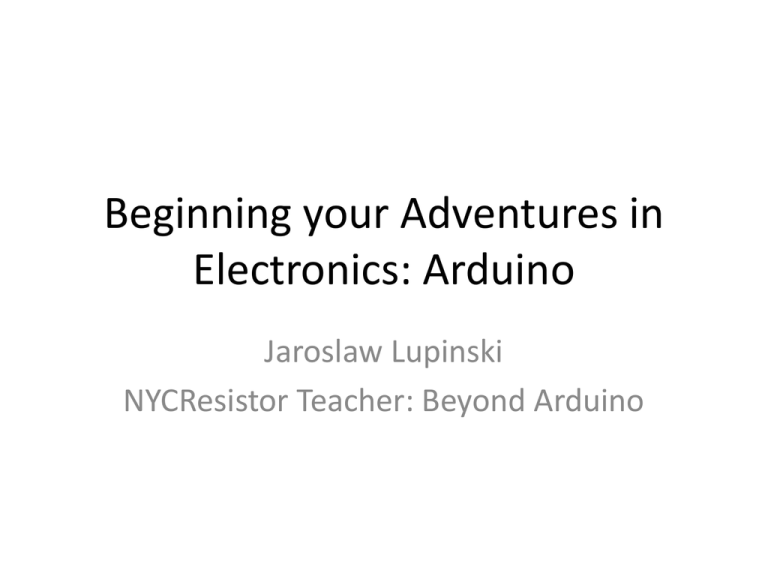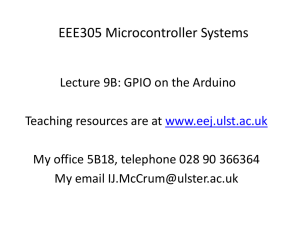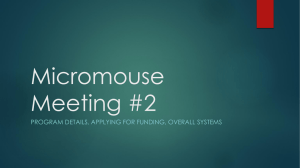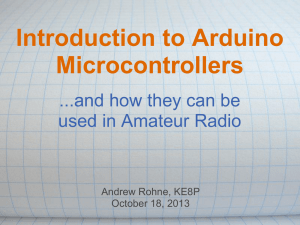Arduino as a Prototyping Platform
advertisement

Beginning your Adventures in Electronics: Arduino Jaroslaw Lupinski NYCResistor Teacher: Beyond Arduino The Recent Revolution • Arduino has dominated the market • Low-cost, easy to use • Less hardware logic, more software • Programmed in C++ What is the Arduino • • • • • Easy to use platform Ease of programming Simple USB interface Modifiable IDE Many shields available Components of the Arduino • ATMega168/328 • 16MHz crystal/filtering capacitors • Onboard power regulators • FTDI USB <-> Serial Chip • Hardware Schematic Necessary parts for any circuit • ATMega168/328 • The ‘brains’ of the Arduino • Program is loaded onto the chip • Runs main loop until power is removed • That’s it! All other parts are optional! Optional parts: Timing • 16Mhz Crystal • The ‘heartbeat’ of the ATMega chip • Speed of crystal determines chip speed • Possible to over/underclock depending on application • ATMega series has onboard oscillator; less precise Power Supply • 5 Volt and 3.3 Volt Regulators • Filtering capacitors • Automatic switching between external and USB Power • Leave it out if you have a filtered 5 Volt power supply FTDI USB Chip • Allows your Arduino to communicate with your computer over a simple USB link • Abstraction • Only necessary for communicating with USB Hardware • • • • • Circuit Board Headers USB port Sockets All optional, use them if you need them Two methods of using the Arduino • Working with the Arduino to solve a problem • Temporary solution • One time only • Prototyping with the Arduino to solve a need • Preparing a product for market • Mass production Phases of Circuit Design Arduino Approach •Idea •Sketch •Read datasheets •Gather materials •Prototype •Testing •Optional ----------------> Stand-alone approach •Idea •Sketch •Read datasheets •Gather materials •Prototype •Testing •Refining •Testing •Release to manufacture Using the Arduino as a Prototyping Platform • You can prototype using an Arduino, and skip many steps from the stand-alone approach • Use the Arduino to develop your product • When your planned circuit works, skip straight into standalone product testing Idea • Problem to be solved • Market need to be filled • “Necessity is the mother of all invention.” Sketch • Draw out what you need to do to solve your problem • No need to get technical, rough ideas and abstractions will suffice • Take constraints into consideration: Size, budget, audience Optional step: Present • If the project requires substantial resources (funding, rare materials/components), you will need to create a presentation • Venture capitalists • Crowd-sourcing • Material Sourcing Read datasheets/Gather materials • Start turning sketch into reality • Read about chips/parts that are available • Examine options for unavailable/nonexistent parts • Order materials Prototype • Using protoshield or long jumper wires, develop your solution • Attach external chips, sensors, circuits • Leave breadboarded or solder permanently • Most hands-on part, usually taught in labs or dedicated classes Side-note: How to learn to prototype • Desire • Choose a project that appeals to you • Easier to rebuild an existing circuit, or have an experienced tutor for your first design • Time-Cost/Experience tradeoff: Premade kits are less expensive, but may teach less technical skills • Example of good first projects to complete by yourself: – Digital Clock – Basic Robot • Good projects to complete with a tutor: – Nixie tube clock – Advanced Robot Testing • Does it fulfill it’s purpose? • Can it be optimized? • Can you add/remove features? (consider cost) • Have friends, family, colleagues break it! • Debugging Creating a Stand-alone Product • Sketch out Arduino circuit • Eliminate unnecessary/ redundant components • Add broken-down Arduino circuit back into design Side-Note: Making your own shield • Depending on your audience, you may choose this route • Best of both worlds approach • Assurance that it will work with any Arduino: The Mac Approach • Limited to Arduinoowning market That’s the great thing about Arduino • Programming an identical chip with the same Arduino code will result in identical execution • No need for complicated IDE, porting code Using EAGLE to design your circuit • Powerful schematic capture tool • Integrated circuit board design tool • Free version’s limitations are enough for a shield Lay out the circuit board • Position components using electrical engineering principles • There aren’t many, but there are a few critical ones • Power supply splitting, Star Ground, Ground plane, EMI Take your time laying out the board • Most designers spend ~5-10 hours laying out a simple shield! • Personal preferences, aesthetic appeal, ease of use, ease of manufacturing Send circuit board out for production • Research fabrication houses • Compare rates, lead times, shipping • Consider assembly Marketing • Kickstarter! • Word of mouth • Reach out to hackerspaces/hacker fairs • Get people talking about it! Cost Analysis • Determining costs is usually done at the idea phase • Spreadsheets! • Excel is your friend • Understand that prices rise and fall, stock is depleted and replenished, and suppliers may fail to deliver • The longer it takes to develop, the more variables will develop Start selling your product! • Keep up to date on your products status • Twitter, Facebook, Blogs, News • Every product is 1% inspiration, 9% perspiration, and 90% marketing! Congratulations! • You are now a marketable inventor! • Consider patenting your idea if it is worth more than $10,000 • Open source alternatives • Creative Commons Understand that your product will not always sell • Many factors go into making a successful product • Even if you did all the steps correctly, you may still fail to make a profit • Engage the customers that you do bring in Questions/Comments • Notes: • • • • Contact: Jaroslaw Lupinski jarek@soniktech.com AIM: jarek319






